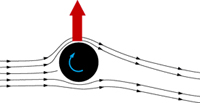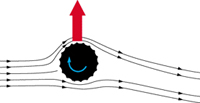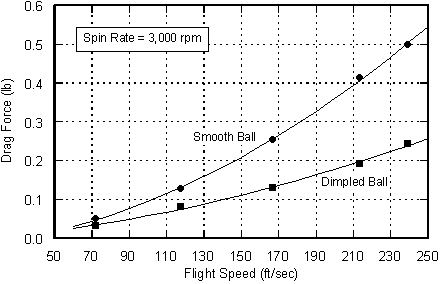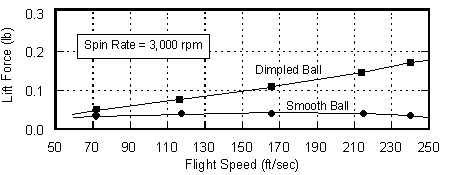

Thanks is extended for the use of this graphic http://www.titleist.com/htm/tech/aero5.asp
The Aerodynamics of Dimples

Thanks is extended for the use of this graphic http://wings.avkids.com/Book/Sports/instructor/golf-01.html
The golf ball seemingly defies gravity by flying farther than a smooth ball of the same mass and size. This is due to the texture of the ball itself. As explained in the introduction a golf ball creates a layer of turbulence that lessens the friction between it and the air. The dimples in the balls surface also reduce the drag on the ball again due to the amount of air traveling at the same speed as the surrounding air. Reducing the forces acting against the balls flight allow the ball to fly an increased distance before gravity takes over. Experiments have been done on the shape, size, depth, and number of the dimples on a golf ball. The golf ball could be further improved upon.
The drag of a smooth ball compared to a dimpled ball.


Thanks is extended for the use of this graphic http://www.titleist.com/htm/tech/aero4.asp
The lift due to spin of a smooth ball compared to a dimpled ball.


Thanks is extended for the use of this graphic http://www.titleist.com/htm/tech/aero4.asp
The fact that a dimpled ball has lift is not true. This effect is due to the spin of the ball and explained by the magnus effect included in Aerodynamics of Flight. A spinning golf ball has more lift than a smooth ball because pressure of the air is different from one side of the golf ball to the other. The following graphs show the drag force on a dimpled ball vs. a smooth ball and the force of lift due to spin on a dimpled ball vs. a smooth ball.

Thanks is extended for the use of this graphic http://www.titleist.com/htm/tech/aero5.asp

Thanks is extended for the use of this graphic http://www.titleist.com/htm/tech/aero5.asp






Thanks is extended for the use of this graphic http://www.titleist.com/htm/tech/aero5.asp